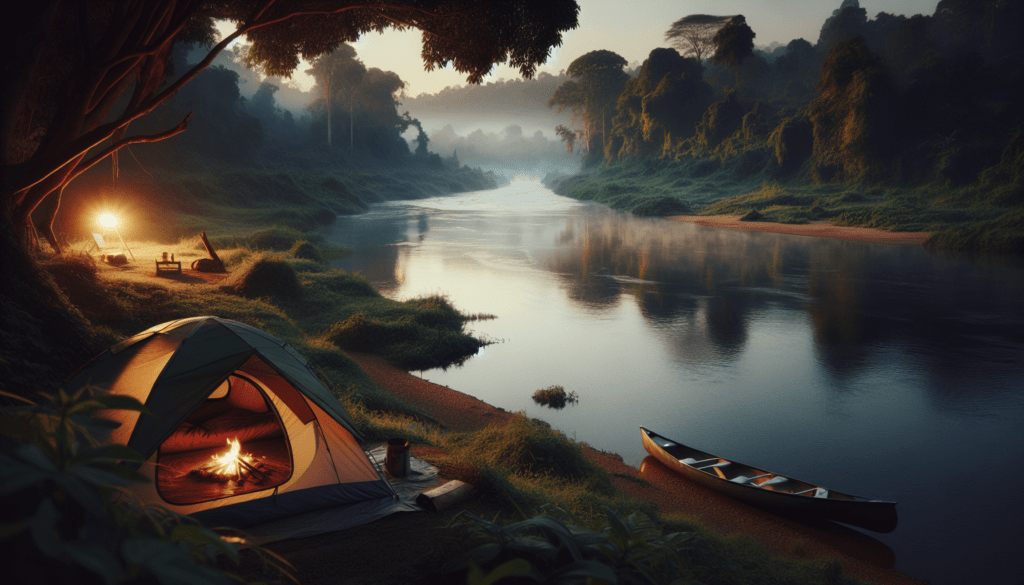Have you ever thought about camping near water and wondered about how to stay safe while doing so?
Camping by lakes, rivers, or the ocean offers a unique way to connect with nature. From fishing and swimming to simply enjoying the serene sounds of flowing water, the benefits of water-side camping are numerous. However, the presence of water also introduces specific risks that you need to manage to ensure a safe and enjoyable experience. This article will walk you through all the safety precautions you need to consider when camping near water.

Understanding the Risks
Drowning Hazards
Drowning poses the most significant risk when camping near water. Whether it’s swift river currents, deep lake waters, or strong ocean tides, understanding the nature of the water body you’re camping near can significantly reduce risks. Always scout the area and look for signs or information about water depths and currents.
Sudden Changes in Water Levels
Natural water bodies can experience abrupt changes in water levels due to weather, dam releases, or tides. Flash floods, for instance, can occur with little warning and transform a tranquil camping site into a dangerous scenario. Awareness and preparedness can make a crucial difference.
Wildlife Encounters
Water bodies often attract various forms of wildlife, including some potentially dangerous animals like snakes, sharks, or alligators. Being aware of the types of animals in your camping area can help you take appropriate precautions.
Cold Water Shock
Cold water shock is a sudden, involuntary gasp of air when you first enter cold water. This can lead to drowning even in strong swimmers. Understanding the water temperature before diving in is essential.
Safety Precautions to Follow
Choosing a Safe Campsite
Selecting a good campsite is your first line of defense against water-related dangers. Look for flat terrain elevated above the waterline to avoid sudden water level changes. Ensure your tent is at least 200 feet away from the water to minimize the risk.
Checking Weather Forecasts
Weather conditions significantly impact water safety. Rain and thunderstorms can lead to rising water levels and flash floods. Before you set out, check the weather forecast for the area. It’s also a good idea to have a reliable weather app on your phone for real-time updates.
Swimming Safety
Knowing how to swim is essential but not enough by itself. Wearing a life jacket, never swimming alone, and avoiding swimming after consuming alcohol can go a long way in ensuring your safety. If you’re not a strong swimmer, stick to shallow areas and always pay attention to warning signs.
Utilizing Life-Saving Equipment
Carrying some essential safety equipment can make a world of difference. Here are some items you might consider:
| Equipment | Purpose |
|---|---|
| Life Jackets | Provides buoyancy for swimming or in cases of accidental falls |
| Whistles | Helps in alerting others in case of emergency |
| First Aid Kit | Immediate response to injuries or sudden illnesses |
| Ropes | Useful for rescues or securing tents and gear |
Being Aware of Local Regulations
Every camping area has its own set of rules that often include guidelines for water safety. Ignoring these can lead to trouble. Always go through local regulations to understand restricted areas, fishing limits, and whether swimming is allowed.
Emergency Procedures
Creating an Emergency Plan
Having a well-thought-out emergency plan significantly boosts your chances of effectively handling any water-related mishaps. This includes knowing the nearest medical facilities, having emergency contact numbers handy, and ensuring that everyone in your group is aware of the plan.
What to Do in Case of Drowning
If someone is in trouble in the water, every second counts. Here are quick steps you should follow:
- Alert Others: Shout to get the attention of others around.
- Throw a Floatation Device: If available, throw a rope, life jacket, or any floatation device toward the person.
- Do Not Jump In: Unless you’re trained in water rescue, jumping in can put both of you at risk. Try to extend a branch or hold onto a rope and pull them to safety.
- Call Emergency Services: Contact AAA or local emergency services immediately for professional help.
Handling Hypothermia
Cold water can lead to hypothermia, a dangerous drop in body temperature. Here’s how to handle it:
- Get the Person Out of the Water: Immediately remove wet clothing and warm them up using blankets or dry clothes.
- Monitor Breathing and Circulation: Ensure the person is breathing correctly and seek immediate medical attention.
- Provide Warm Drinks: Offering warm fluids can help raise body temperature but avoid alcohol and caffeine.

Food and Water Safety
Storing Food Properly
Camping near water often means you’ll have more wildlife encounters. Storing your food correctly can make a big difference:
- Use Bear-Resistant Containers: If you’re in bear country, this is non-negotiable.
- Hang Food Bags: Suspend food bags from trees to keep them out of reach of most animals.
- Seal and Store Fishing Bait: Keeping bait sealed reduces unwanted animal attraction.
Safe Drinking Water
Drinking from lakes, rivers, or streams can result in waterborne illnesses. Making sure your drinking water is safe should be a priority:
- Boil Water: Bringing water to a rolling boil for one minute kills most pathogens.
- Use Water Purification Tablets: These can neutralize dangerous microorganisms.
- Portable Water Filters: These are handy for removing bacteria and protozoa from water.
Handling Human Waste
Designated Areas
Using designated bathroom facilities whenever possible is the easiest way to ensure hygiene and environmental preservation. However, if no facilities are available, follow proper procedures for disposing of human waste:
- Portable Toilets: Portable camping toilets can be an excellent option for maintaining hygiene.
- Digging a Cat Hole: If you have to dig a hole, make sure it’s at least 200 feet away from any water source and bury waste at least 6-8 inches deep.
Pack Out What You Pack In
This principle is crucial for maintaining the integrity of the environment. Always carry out all waste, used tissues, and hygiene products to dispose of them properly.
Fire Safety Near Water
Choosing a Safe Location for Campfires
Water might be nearby, but fire safety is still important. Always choose a fire site that’s at least 15 feet away from tents and any forested areas. Ensure the fire pit is surrounded by rocks to contain sparks.
Extinguishing Fires Properly
Use water to douse the campfire completely before you head to bed or leave the campsite. Stir the ashes and add more water until everything is cool to the touch.
Protecting the Environment
Leave No Trace
The Leave No Trace principles are simple but crucial:
- Plan Ahead: Know the regulations and special concerns for the area you’ll visit.
- Travel and Camp on Durable Surfaces: Stick to existing trails and campsites.
- Dispose of Waste Properly: This includes food scraps and biodegradable materials.
- Leave What You Find: Preserve the beauty for others to enjoy.
- Minimize Campfire Impact: Use a camp stove for cooking and keep fires small.
- Respect Wildlife: Observe animals from a distance and do not feed them.
- Be Considerate of Other Visitors: Respect other visitors and protect the quality of their experience.
Specific Environmental Concerns
Different water bodies come with various environmental concerns. For example, fragile coastal dunes can be easily damaged by foot traffic. Always research the unique ecological aspects of the place you’re visiting and adjust your behavior accordingly.
Practical Tips for Enjoyable Water-Side Camping
Gear Essentials
Camping by the water may require some specialized gear:
- Waterproof Tents and Bags: Essential to keep your belongings dry.
- Mosquito Nets and Repellent: Water bodies attract insects.
- High-Quality Footwear: For navigating potentially slippery or rocky terrains.
Fun Water Activities
While safety is paramount, don’t forget to enjoy the water! Activities like kayaking, paddleboarding, and fishing can add a lot to your camping experience. Just remember to follow all safety guidelines specific to each activity.
Checking for Warnings and Hazards
Regularly check for posted warnings or signs about water quality, hazardous wildlife, or any other potential dangers. Pay attention to other campers’ experiences and advice, as they can provide invaluable real-time insights.
Summary
Camping near water offers a refreshing way to connect with nature, but it also comes with its own set of risks. By choosing a safe campsite, being aware of sudden weather changes, and understanding local wildlife, you significantly increase your chances of a safe camping trip. Utilize essential safety equipment, follow local regulations, and always have an emergency plan in place. Prioritize food and water safety, practice responsible waste disposal, and protect the environment by adhering to Leave No Trace principles. Lastly, while you enjoy activities like swimming, fishing, or kayaking, remember safety must always come first.
You’ll find that with the right precautions, camping near water can be an exhilarating and safe way to immerse yourself in the great outdoors. Stay safe and enjoy the adventure!
Support us! Wilderness gear Pro may earn a small commission from affiliate links in this article. Learn More

